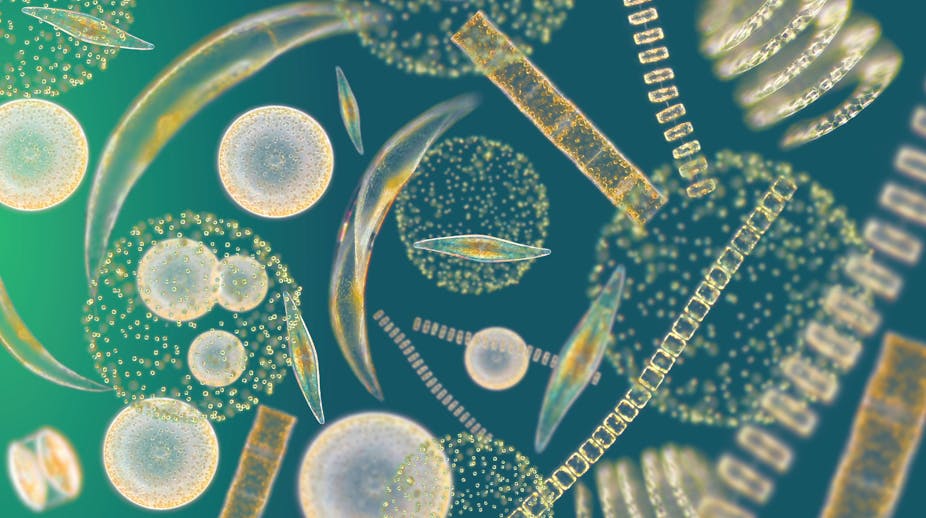Phytoplankton are the microscopic plant-like cells that float in the sea’s sunlit surface. They underpin the marine food chain and controversy over their stocks means it’s necessary to better understand their existence across the globe. To combat the lack of data on phytoplankton levels, colleagues at Plymouth University and I initiated a project to map them in oceans across the world. Lacking the manpower to do this on our own, we are enlisting seafarers across the globe to get involved in the project.
Phytoplankton are the ocean’s main producers – their abundance determines the productivity at every step of the marine food chain above them. This means they determine the numbers of fish in the sea, crabs on the seashore, seabirds in the sky and polar bears on the ice.
So when three Canadian scientists published research in Nature describing a 40% decline in phytoplankton in the world’s oceans over the past 50 years, alarm bells were raised. The 2010 study speculated that a warmer ocean surface due to climate change had reduced vertical mixing and the supply of nutrients to the sea surface from deeper waters.
Controversy abounded, however, as some scientists viewed contradictory results and others no changes. One problem suggested with the Canadian study was the reliability of the data used (and available). Since the phytoplankton begin the marine food chain, we need to know more about if, how and why they are changing in order to understand the effects on the ocean’s biology.
Secchi disks in the hands of sailors
We are asking sailors around the world to take Secchi Disk readings to add to the historical dataset collected by scientists over the last 150 years. Using this data, we hope to build a map of the oceans, charting the seasonal and annual changes of phytoplankton from now and into the future.
A Secchi Disk is one of the simplest pieces of marine scientific equipment. It is a round, 30cm white disk attached to a tape measure with a small weight hanging below. It was first invented in 1865 by the Pope’s astronomer Pietro Angelo Secchi and is used to determine the clarity of seawater.

When lowered over the side of a ship the depth at which the white disk just disappears from sight is recorded and it indicates the clarity of the seawater. In water greater than 25 m deep and more than 1km off shore, the main influence upon water clarity is the phytoplankton, and so the recording determines the amount of phytoplankton in the water. It is a simple and robust measurement.
A Secchi Disk can be made of any material, as long as it is 30cm in diameter and plain white. Part of the project involves seafarers making their own Secchi Disks. As we expected, sailors have used a very diverse range of materials. The more unusual items we have heard about include an aluminium road sign, a frisbee and a disk cut from a ship’s toilet seat lid.
Developing a smart app
To make it simple for seafarers to take Secchi depth readings, colleagues from Plymouth’s School of Computing and Mathematics created the Secchi smartphone app. The app can be used anywhere in the world – whether or not they have any signal.

In parts of the world without internet connection, participants record as many Secchi readings as they like on the app and these are stored as “pending readings” on the phone. Exactly how many pending readings can be stored depends on the capabilities of the phone, but the number is very large. These can then be uploaded at a later date when an internet connection is available.
In the hands of so many different seafarers, it was important to design an app that would keep errors to a minimum. The participant’s location is taken from the phone’s GPS to eliminate any transcription errors. The user interface has been designed to work well on a boat at sea: small and unfussy layouts are used. The “depth disk” uses a logarithmic scale to enable shallow readings to be entered quickly and accurately.
The Secchi Disk project has just celebrated its first birthday and we are thrilled with the enthusiasm of sailors to take part. After one year, a sailor is measuring phtyoplankton from somewhere in the world’s oceans almost every day. So far, the most southern Secchi Depth was recorded by near Wananga in waters of New Zealand and the most northern reading taken in the sea of the Northern Isles of Scotland.
Entering its second year, the project has several goals over and above recruiting more participants and growing and using the database. For example, we would like to see Secchi Disks included onboard holiday charter yachts, included as an item with every new yacht, and, although we like the DIY approach, we are keen to find someone to produce an inexpensive Secchi Disk apparatus for sale in shops. As more data is collected, we hope to soon start analysing it and mapping the world’s phytoplankton.

